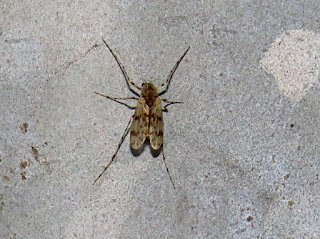Priorslee Lake: 05:15 – 06:55 // 07:50 – 09:30
The Flash: 07:00 – 07:45
12.0°C > 13.0°C: Overcast, initially all medium / high-level, later more low-level cloud as well. Moderate SW breeze. Very good visibility.
Sunrise: 06:28 BST
Priorslee Lake: 05:15 – 06:55 // 07:50 – 09:30
(216th visit of the year)
A quieter day with fewer geese, many fewer gulls and fewer Chiffchaffs. Good variety of insect life on the lamps pre-dawn.
Bird notes from today:
- The geese chose different outbound flight lines with birds low over (and behind?) trees to both S and N of the lake.
- Yet another change in the Great Crested Grebes. Back to four full-grown and independent juveniles. One of the broods in the NW area remained uncounted, sheltering on the parent’s back. And one of the adults from the long-term non-breeding pair seemed to be missing.
- No juvenile Coots identified. One very small juvenile something seen scurrying in to cover was not a Coot but remained unidentified.
- 51 House Martins over at 06:45 in a tight group. These soon disappeared. Where do they come from and go to? And why? Later a loose group of 11 birds headed SW.
- This morning’s ‘football’ field count gave me 208 Black-headed Gulls, 16 Wood Pigeons, six Magpies, the usual two Carrion Crows, one Grey Wagtail and 61 Pied Wagtails. There were just three Black-headed Gulls on the school playing field. A passing local Buzzard disrupted things and all the gulls and pigeons flew off with only some returning. The wagtails stayed put. Later two Grey Wagtails were on the dam.
- A Tawny Owl was calling close to the Teece Drive gate early. First I have heard for several weeks.
- Where are all the Blackbirds? Throughout the breeding season c.20 males, many of them singing, were easy to find. Latterly females and juveniles were also much in evidence. Today just four birds heard with none seen – typical of the last few days.
Bird totals:
Birds noted flying over or flying near the lake:
- 142 Greylag Geese (58 outbound in six groups; 84 inbound in six groups)
- 60 Canada Geese (28 outbound in two groups; 32 inbound in two groups)
- 1 Common Kestrel
- 13 Lesser Black-backed Gulls: 5 of these first- winter birds
- 32 large gulls (still too dark to ID)
- 2 Stock Doves
- 30 Wood Pigeons
- 18 Jackdaws
- 91 Rooks
- 17 Starlings
Hirundines etc. noted:
- 2 Barn Swallows
- 62? House Martins
Warblers noted (singing birds):
- 7 (1) Chiffchaffs
- 1 (0) Blackcap
Counts from the lake area:
- 2 + 6 (1 brood) Mute Swans
- 14 (7♂) Mallard
- 3 (0♂) Tufted Ducks remain
- 1 Cormorant
- 1 Grey Heron again
- 1 immature Little Grebe
- 7 + 4 + >6 (3 broods) Great Crested Grebes (see notes)
- 3 Moorhens (not aged)
- 80 Coots
- >210 Black-headed Gulls
- 16 Lesser Black-backed Gulls : 14 of these first-winter birds and one a second-winter bird.
- 3 Herring Gulls : all of these first-winter birds
On the lamp poles pre-dawn:
- 1 micro moth, perhaps Schreckensteinia festaliella
- 1 Garden Carpet moth (Xanthorhoe fluctuata)
- 1 Setaceous Hebrew Character moth (Xestia c-nigrum)
- 1 wood gnat, possibly Sylvicola punctatus
- 1 fungus gnat of the genus Macrocera
- 1 Garden Spider (Arameus diadematus)
The following logged later:
The only insects on cloudy morning
- 2 Chequered Hoverflies (Melanostoma scalare)
Nothing else noted
(Ed Wilson)
------------------------------------------------------------------------------------------------------
The Flash: 07:00 – 07:45
(206th visit of the year)
Notes from here:
- Only one of the two juvenile Great Crested Grebes seen.
- There was probably a Sparrowhawk around somewhere. All the Wood Pigeons shot off and the tits, especially Long-tailed Tits, gave persistent alarm calls. I could see nothing.
- Probably the same juvenile Common Buzzard was calling overhead and also from the wood at the top end of the water.
and, all on lamp poles
- 1 Common Marbled Carpet moth (Dysstroma truncata)
- 1 fly with very hairy legs
- 1 Ant Damsel Bug (Himacerus mirmicoides)
- 1 Common European Earwig (Forficula auricularia)
- 5 Dicranopalpus ramosus harvestmen
- 2 Leiobunum rotundum harvestmen
with
- several fungus, either False Chanterelle (Hygrophoropsis aurantiaca) or Saffron Milkcap (Lactarius deliciosus)
Birds noted flying over / near The Flash:
- 1 Common Buzzard
- 1 Lesser Black-backed Gull
- 3 Stock Doves
- 10 Wood Pigeons
- 1 Jackdaw
Hirundines etc. noted.
None
Warblers noted (singing birds):
- 3 (0) Chiffchaffs
Counts from the water:
- 3 Mute Swans as usual
- 1 Canada Goose only
- 28 (14♂) Mallard
- 22 (9♂) Tufted Ducks
- 1 Grey Heron
- 2 + 1 (1 brood) Great Crested Grebe
- 4 Moorhens
- 15 Coots
- 1 adult Black-headed Gull
- 1 Kingfisher
I think this is the Ant Damsel Bug (Himacerus mirmicoides). Never seen one of these before.
There were c.10 in the area. Here are a few. There seems to be a few old pine needles in this view ....
(Ed Wilson)
------------------------------------------------------------------------------------------------------
Between the lake and The Flash
- 1 Chiffchaff calling from around the upper pool.
(Ed Wilson)
------------------------------------------------------------------------------------------------------
On this day..........

















